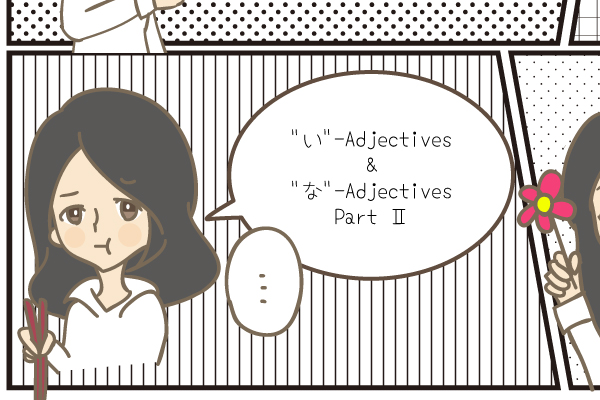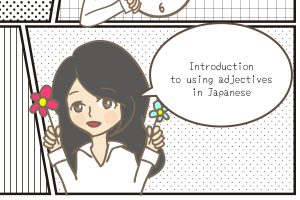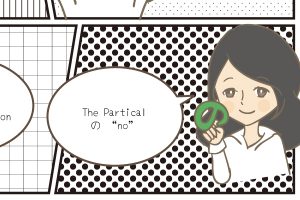Introduction to using adjectives in Japanese Part 2
Last time Shiho introduced the “の”-particle and its basic uses in Japanese. For this lesson, we return to “い”- and “な”-adjectives and how to express them in the past tense.
| Table of Contents [Revision] [過去形: Adjectives in the past tense: “い”-Adjectives] [過去形: Adjectives in the past tense: “な”-Adjectives] [Exceptions] [Two points to keep in mind] |
[Revision]
Two weeks ago Shiho introduced the very basics to using adjectives in Japanese. We learned how to combine them with nouns and how to negate them. In this lesson, we will take a look at how to express adjectives in the past tense.
But before we get started, let’s revise part of what we studied two weeks ago!
As you might remember, adjectives in Japanese are divided into “い”- and “な”-adjectives. Do you remember how you can negate “い”-adjectives? In order to negate “い”-adjectives, you replace the very last “い” of the adjective with a “く” and add the negator “ない”. See the example below:
| 美味しい → 美味しく+ない → 美味しくない | Delicious → Not delicious |
In order to express the same meaning in polite speech, you can either add a “です” after the “ない” or replace the “ない” with “ありません”. See the example below:
| 美味しくないです。 美味しくありません。 |
Not delicious |
Now, let’s revise how to do the very same thing with “な”-adjectives. In order to negate “な”-adjectives, you simply put “じゃない” – or to be a bit more formal “ではない” – behind the adjective. See the example below:
| きれい → きれいじゃない。 きれい → きれいではない。 |
Pretty → Not pretty |
If you want or need to be more formal, simply replace the “ない” with “ありません”:
| きれい → きれいじゃありません。 きれい → きれいではありません。 |
Not pretty |
In conversations (but not in written Japanese, especially not formal one), you can also add “です” after “じゃない” or “ではない” to negate the sentence more politely:
| きれいじゃないです。 きれいではないです。 |
Not pretty |
That sums up the revision – now, let’s move on!
[過去形: Adjectives in the past tense: “い”-Adjectives]
Now, let’s move on and learn how to express adjectives in the past tense. Let’s start off with “い”-adjectives.
In order to express “い”-adjectives in the past tense, simply omit the very last “い” of the adjective and replace it with “かった”:
| 美味しい。 → 美味しかった。 | Delicious → Was delicious |
In order to negate an “い”-adjective in the past tense, just like with the present tense, you omit the very last “い”, replace it with “く”, and then add the past tense of the negator, which is “なかった”:
| 美味しくない。 → 美味しくなかった。 | Not delicious → Was not delicious |
Let’s put the word “大きい” into the past tense, using the positive and negative forms:
| 大きい。 → 大きかった。 | Big → Was big |
| 大きくない。 → 大きくなかった。 | Not big → Was not big |
Now, these forms are as always very basic and hence not very polite. Luckily, turning adjectives in their past tense into polite speech is fairly easy – simply add “です”:
| 大きかったです。 | 大きくなかったです。 |
A somewhat more formal way to express the negative form of past tense adjectives is to add “ありませんでした” instead of “なかったです”:
| 大きくありませんでした |
[adsense]
[過去形: Adjectives in the past tense: “な”-Adjectives]
Next, let’s take a look at “な”-adjectives. Usually, when you use these adjectives in a sentence, you have to attach “だ” behind them to make them work in the sentence. For example:
| この花はきれいだ。 | This flower is pretty. |
In order to transform “な”-adjectives into their past form, you have to switch “だ” into its past form: “だった”. For the negative form, you put the negator “ない” into its past form: “なかった”. See the examples below:
| きれいだ → きれいだった | Pretty → Was pretty |
| きれいじゃない → きれいじゃなかった | Not pretty → Was not pretty |
In order to express these in a more polite way, you simply change “だった” to the polite form “でした”. For the negated adjectives, you can simply add “です” after “なかった”, which is more conversational, or replace “なかった” with the more formal “ありませんでした”.
| きれいでした きれいじゃありませんでした きれいではありませんでした |
きれいじゃなかったです きれいではなかったです |
[Exceptions]
Of course, from every rule there is an exception. In Japanese, one of those exceptions is the adjective “いい”, meaning “good”. To put “いい” in the past tense in a positive or negative statement, see below:
| いい → よかった | Good → Was good |
| よくない → よくなかった | Not good → Was not good |
To put this into polite speech, just add “です”, or, for the negative form, replace “なかった” with “ありませんでした” to make it more formal:
| よかったです よくなかったです よくありませんでした |
[Two points to keep in mind]
Lastly, there are two things to keep in mind when studying adjectives and past tense.
First: Depending on what your mother tongue is, there might not even be a “past tense” for adjectives, or it may not be necessary to change the adjectives themselves. However, in Japanese you always need to change the adjectives to their past tense if you are using them in the context of the past.
Second: About the word “よかった”. Of course, literally translated the word “よかった” means that something “was good”. However, in Japanese it is often used in a way to express someone’s feeling of relief over something. Depending on the context, it can therefore often be rather translated as “thank goodness!” instead of “was good”. For example:
| 試験に合格してよかった! | Thank goodness I passed the test! |
| 先々週 | Week before last |
| 二週間前 | Fortnight ago, two weeks ago |
| 過去形 | Past tense |
| 復習 | To change |
| もしくは | Or, otherwise |
| 当てはまる | To apply (e.g. a rule) |
| 母国語 | Mother tongue |
| 肯定 | Positive (statement) |
| 否定 | Negative (statement) |
| 安心 | Relief |
| 気持ち | Feeling |
| 表す | To show, to express |
| 試験 | Test, examination |
| 合格 | Success, passing (e.g. of a test) |





